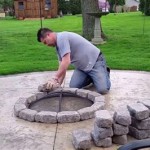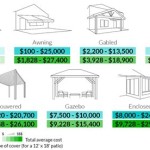Concrete Patio Slab Ideas: Design, Finishes, and Enhancements
A concrete patio slab represents a practical and versatile outdoor living space solution. Its durability and relatively low maintenance make it a popular choice for homeowners. However, the inherent simplicity of concrete can sometimes feel aesthetically limited. Fortunately, numerous design ideas, finishing techniques, and enhancement strategies exist to transform a plain concrete slab into a visually appealing and functional patio area.
Stamped Concrete: Mimicking Natural Materials
Stamped concrete offers a method to replicate the appearance of more expensive materials such as brick, stone, or wood. This technique involves imprinting patterns into freshly poured concrete using specialized stamps. The resulting texture and design create a visually interesting surface that can significantly elevate the patio's aesthetic. The benefits extend beyond appearance as stamped concrete can be tinted with integral colors or stained after curing to further enhance its realism and complement the surrounding landscape.
The process requires careful preparation and skilled execution. Before pouring the concrete, the desired pattern and color scheme need to be chosen. The forms must be precisely set to ensure accurate dimensions and a level surface. Once the concrete is poured and leveled, a release agent is applied to prevent the stamps from sticking. The stamps are then carefully placed and pressed into the concrete, creating the desired pattern. After the concrete has cured sufficiently, the release agent is washed off, and a sealant is applied to protect the surface and enhance its color. The choice of sealant impacts the appearance and durability of the finished product. Options ranging from matte to high-gloss sealants can be selected depending on the desired aesthetic and maintenance considerations.
Stamped concrete is a highly customizable option, allowing for a wide range of design possibilities. Options include patterns mimicking ashlar slate, cobblestone, brick, or even intricate custom designs. The color options are equally extensive, allowing for a seamless integration with the home's exterior and landscaping. Selecting the appropriate patterns and colors can transform a basic concrete slab into a luxurious and inviting outdoor space.
Exposed Aggregate Concrete: A Textured and Durable Finish
Exposed aggregate concrete offers a durable and visually appealing alternative to traditional smooth concrete finishes. This technique involves removing the top layer of cement paste to reveal the decorative aggregate beneath. The exposed aggregate can consist of various materials, including pebbles, stones, shells, or even recycled glass. This creates a textured surface that is both slip-resistant and aesthetically pleasing.
The process involves pouring and leveling the concrete as usual. After the concrete begins to set, a surface retarder is applied. This chemical slows down the curing process of the top layer, allowing the underlying concrete to harden while the surface remains relatively soft. After a specified curing period, the surface is washed or brushed to remove the uncured cement paste, revealing the exposed aggregate. The aggregate can be selected to complement the surrounding landscape and architectural style of the home. Different sizes, colors, and types of aggregate offer a wide range of design possibilities.
The benefits of exposed aggregate concrete extend beyond its appearance. The textured surface provides excellent slip resistance, making it a safer option for patios, especially in areas prone to moisture. The exposed aggregate also enhances the concrete's durability, making it more resistant to abrasion and weathering. Proper sealing is essential to protect the aggregate and prevent staining. Regular cleaning and resealing will help maintain the appearance and longevity of the exposed aggregate concrete patio.
Colored Concrete: Adding Vibrancy and Depth
Coloring concrete offers a simple yet effective way to enhance its aesthetic appeal. Concrete can be colored using various methods, including integral color, dry-shake hardeners, and stains. Each method provides a different level of color intensity and durability. Integral color is added to the concrete mix before pouring, resulting in a consistent color throughout the slab. Dry-shake hardeners are applied to the surface of the wet concrete and worked into the surface, providing a durable and vibrant color. Concrete stains penetrate the concrete surface, creating a translucent color that highlights the natural variations and textures of the concrete.
Choosing the right coloring method depends on the desired effect and budget. Integral color is the most cost-effective option and provides a consistent color throughout the slab. Dry-shake hardeners offer a wider range of colors and greater durability. Concrete stains provide a more natural and nuanced look, allowing the concrete's texture to show through. It is important to consider the surrounding landscape and architectural style of the home when selecting a color. Earth tones, such as browns, grays, and tans, are popular choices for patios as they blend well with natural surroundings. Brighter colors can be used to create a more contemporary and vibrant look.
Proper surface preparation is essential for achieving optimal color results. The concrete surface should be clean, dry, and free of any contaminants. For stains, it is often recommended to acid etch the concrete surface to open the pores and allow for better penetration. Sealing the colored concrete is crucial for protecting the color and preventing fading. A UV-resistant sealant is recommended for patios that are exposed to direct sunlight. Regular cleaning and resealing will help maintain the color and appearance of the concrete patio.
Adding Borders and Inlays: Defining the Space
Incorporating borders and inlays into a concrete patio slab can significantly enhance its visual appeal and define distinct areas within the space. Borders can be created using contrasting colors, textures, or materials, such as brick, stone, or decorative concrete pavers. Inlays involve embedding decorative elements, such as tiles, mosaics, or even metal accents, into the concrete surface.
Borders can be used to frame the patio area, creating a defined edge and adding visual interest. Contrasting colors can be used to create a striking border, while using similar tones can provide a more subtle and integrated look. Different textures, such as exposed aggregate or stamped concrete, can also be used to create a visually appealing border. Inlays can be used to create focal points, patterns, or even personalized designs within the patio. Tiles, mosaics, and metal accents can be embedded into the concrete surface to add color, texture, and visual interest.
The design possibilities for borders and inlays are virtually limitless. Geometric patterns, such as squares, rectangles, and circles, can be used to create a modern and contemporary look. Natural shapes, such as leaves, flowers, and animals, can be used to create a more organic and whimsical feel. Personalized designs, such as initials, monograms, or family crests, can be incorporated to create a unique and personal touch. Careful planning and precise execution are essential for achieving a professional-looking result. The borders and inlays should be properly aligned and secured to ensure a seamless and durable finish. Sealing the concrete surface is crucial for protecting the borders and inlays and preventing them from becoming damaged or stained.
Creating Levels and Steps: Adding Dimension and Functionality
Introducing different levels and steps into the concrete patio design can add dimension, visual interest, and functionality to the outdoor space. Elevated areas can be used to create distinct zones for dining, lounging, or gardening. Steps can be used to connect different levels and provide easy access to the patio from different parts of the yard.
Creating different levels can involve building retaining walls or using earthwork to raise or lower the ground level. The retaining walls can be constructed from various materials, such as concrete blocks, stone, or timber. The steps can be constructed from concrete, stone, or brick and can be designed to match the overall style of the patio. Integrating lighting into the steps can enhance safety and create a visually appealing effect at night.
Careful planning and consideration are essential when designing levels and steps. The levels should be properly scaled to the size of the patio and the surrounding landscape. The steps should be designed with comfortable rise and run dimensions to ensure safe and easy access. Proper drainage is crucial for preventing water from pooling on the patio surface. The levels and steps should be designed to direct water away from the house and into the surrounding landscape.
Adding Outdoor Features: Enhancing Functionality and Ambiance
Incorporating outdoor features into the concrete patio design can significantly enhance its functionality and ambiance. Fire pits, outdoor kitchens, seating walls, and water features can transform a basic patio into a luxurious and inviting outdoor living space. These features extend the usability of the patio, making it a central gathering place for family and friends.
A fire pit can provide warmth and ambiance on cool evenings, creating a cozy and inviting atmosphere. Outdoor kitchens can transform the patio into a gourmet cooking and dining area, allowing for outdoor entertaining and meal preparation. Seating walls can provide comfortable and stylish seating options while also defining the patio space. Water features, such as fountains or ponds, can add a tranquil and relaxing element to the patio, creating a peaceful oasis.
The design possibilities for outdoor features are vast and varied. Fire pits can be constructed from various materials, such as concrete, stone, or brick, and can be designed to burn wood, propane, or natural gas. Outdoor kitchens can be equipped with various appliances, such as grills, smokers, refrigerators, and sinks. Seating walls can be designed in various shapes and sizes and can be upholstered with comfortable cushions. Water features can range from small, tabletop fountains to large, elaborate ponds. Careful planning and coordination are essential when integrating outdoor features into the patio design. The features should be properly sized and positioned to complement the overall design of the patio. Proper plumbing and electrical connections should be installed to ensure safe and efficient operation.
Proper Drainage and Slope: Ensuring Longevity and Preventing Damage
Ensuring proper drainage and slope is crucial for the longevity and performance of a concrete patio slab. Without adequate drainage, water can accumulate on the surface, leading to staining, cracking, and even structural damage. A slight slope should be incorporated into the patio design to direct water away from the house and into the surrounding landscape.
The recommended slope for a concrete patio is typically between 1/8 inch and 1/4 inch per foot. This allows for sufficient drainage without creating a noticeable slant. The slope should be carefully planned and executed during the concrete pouring process. Proper grading and compaction of the subgrade are essential for ensuring a stable and level base for the concrete slab.
In addition to slope, other drainage solutions can be incorporated into the patio design. French drains, which consist of gravel-filled trenches with perforated pipes, can be used to collect and redirect water away from the patio. Surface drains, which are installed flush with the patio surface, can be used to collect water and channel it into a drainage system. Proper drainage and slope are essential for protecting the concrete patio from water damage and ensuring its long-term durability.

Diy Concrete Patio In 8 Easy Steps How To Pour A Cement Slab

Concrete Patio Ideas To Dress Up A Drab Space Bob Vila

Backyard Stained And Stamped Concrete Patios

7 Concrete Patio Design Ideas To Enhance Your Home

Pin On House Ideas

36 Remarkable Concrete Patio Ideas On A Budget

6 Concrete Patio Ideas To Boost The Appeal Of That Drab Slab

Concrete Patio Ideas To Dress Up A Drab Space Bob Vila

20 Design Ideas For Your Concrete Patio

Top 11 Garden Patio Design Ideas Paving Direct
Related Posts








